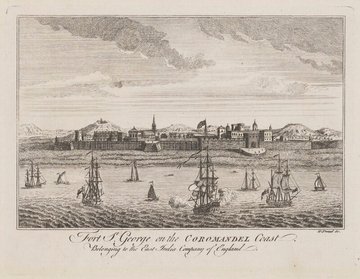
East India Company
‐
Major corporation responsible for British imperial expansion into the Indian subcontinent
Other names
English East India Company
About
The English East India Company was founded at the end of 1600. Queen Elizabeth I commissioned a group of merchants to monopolize trade overseas, in competition with other European trading companies. It expanded rapidly between 1660 and 1700 in terms of trade volume and trading ports. Yet it did not remain only a trading company and in the late eighteenth century began to colonize the Indian subcontinent.
Between 1757 and 1765 the English East India Company annexed land from Bengal and began to build its army in India. Further rapid expansion across India took place between 1783 and 1818. The EIC, as it was known, forced Indian rulers to pay for its troops or otherwise seized their territories. With its military might, the EIC soon grew its imperial control over the Indian subcontinent. In 1793 a landownership system was imposed on Bengal to facilitate collection of revenues. From the mid-1830s the EIC undertook a reformation of India with new land and tax systems, civil law and administration and higher education all moulded along English lines.
The East India Company had an administrative structure that was separate from its commercial arm. From the 1780s administrators were not allowed to own land or conduct trade in India so that their financial interests did not interfere with their work. In 1833 the EIC lost its commercial side and followed parliamentary lines. In 1858, following rebellions in 1857, the British Crown took over control of India from the East India Company. The governance of India was now directly under the control of Parliament. The East India Company was formally dissolved by an Act of Parliament in 1874.
Bayly, C. A., The Birth of the Modern World 1780–1914 (Oxford: Blackwell, 2004)
Cain, P. J. and Hopkins, A. G., British Imperialism: Innovation and Expansion 1688–1814 (London: Longman 1993)
Chaudhuri, K. N. The Trading World of Asia and the English East India Company: 1660–1760 (Cambridge: Cambridge University Press, 1978)
Erikson, Emily, Between Monopoly and Free Trade: The English East India Company, 1600–1757 (Princeton, NJ: Princeton University Press, 2014)
Porter, Bernard, The Lion’s Share: A Short History of British Imperialism 1850–1995 (Harlow: Pearson Education, 1976)
Roos, Dave, ‘How the East India Company Became the World’s Most Powerful Monopoly’, History (23 October 2020), https://www.history.com/news/east-india-company-england-trade
Roy, Tirthankar, The East India Company: The World’s Most Powerful Corporation (Delhi: Penguin, 2012)
Image credit
Fort St George on the Coromandel Coast by W. Proud, after unknown artist, line engraving, mid 18th century, NPG D9166
© National Portrait Gallery, London, Creative Commons, http://creativecommons.org/licenses/by-nc-nd/3.0/
